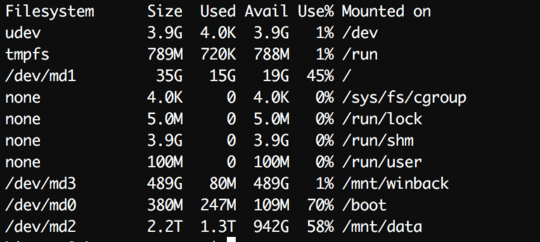1
I am running an Ubuntu Server. Currently, I have the hard drive configuration shown below:
I want to remove the /mnt/winback partition and add the extra space to the /mnt/data partition. What is the best way to do this keeping the other partitions the same?
I have found the article here that shows how to shrink each drive:
Resize underlying partitions in mdadm RAID1
but would the steps be modified like this:
1. Resize the mdadm RAID resize2fs /dev/md2 [size] where size adds the additional space from /dev/md3
2. Remove one of the drives from the RAID mdadm /dev/md2 --fail /dev/sda1 && mdadm /dev/md3 --fail /dev/sda1
3. Remove /dev/md3 from partition table
4. Resize the removed drive to occupy this extra space with parted
5. Restore the drive to the RAID mdadm -a /dev/md0 /dev/sda1
6. Repeat 2-5 for the other device
7. Resize the RAID to use the full partition mdadm --grow /dev/md0 -z max
Does the above seem right? I don't want to mess up my server.

Sorry for the mistakes here but yes it is Raid1. /sda and /sdb make up each array. Also, I have read about making sure bad blocks are detected before doing the above using: repair > /sys/block/md2/md/sync_action. Is this recommended for the above? – J Spen – 2016-11-22T06:12:42.557
THanks a lot. GOt it all sorted. Of note is I cound't remove both /dev/sda3 and /dev/sdb3 but removing one then caling stop everything worked fine. – J Spen – 2016-11-23T18:06:31.247